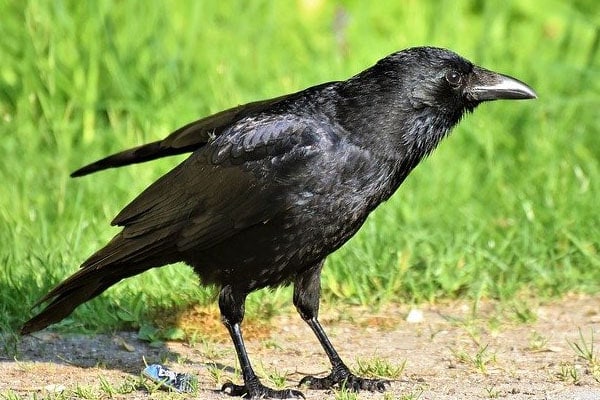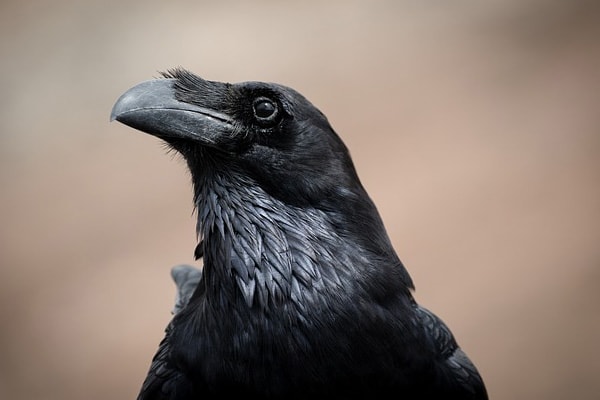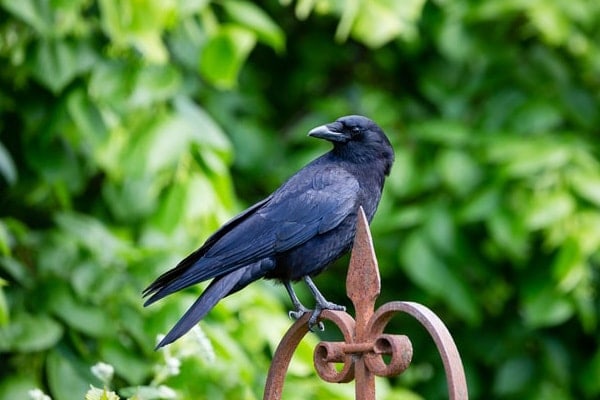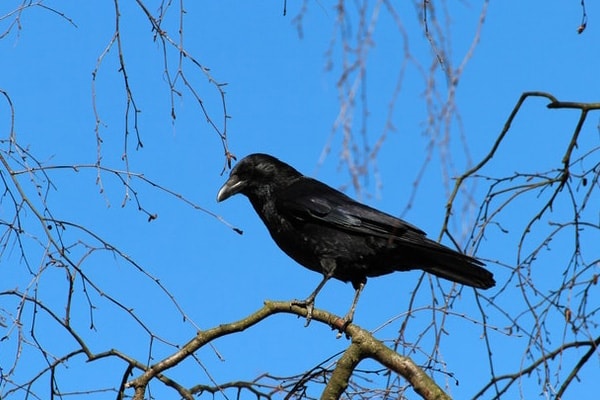Contents
Let’s say you’re having a quiet time outside your home when suddenly a large, black bird passes by. You then start to wonder, is that a raven or a crow?
I know many of us have had these moments, and I can’t blame you because these two are very hard to distinguish. However, although both are known for their full black color,
when it comes to a crow vs. raven,
there are specific differences, and these differences include:
- Physical Appearance
- Bird Call
- Behavior
- Habitat
- Intelligence
- Human Interaction
In this article, we will tackle how the raven and crow differ from each of these attributes. We’re going in-depth from discussing their difference in sizes up to how they socially interact with each other.
And to make this article more interesting, we’ll also tackle some interesting facts about ravens and crows.
So, if these are things you’d want to know, let’s dive into the article…
Physical Appearance

Let’s start with the physical appearance of the two birds. Here, we will compare ravens and crows from their size, color, bill shape, wing shape, tail shape, and other noticeable marks.
Size
Probably one of the easiest factors to determine whether what you’re seeing is a raven or a crow is to look at their size. If you put these two birds side by side, you’ll quickly notice that ravens are significantly bigger than crows.
Ravens grow at a length of 22.1 to 27.2 inches, weigh around 24.3 to 57.3 ounces, and have a wingspan of 45.7 to 46.5 inches. Crows, on the other hand, grow at a length of 15.8 to 20.9 inches, weigh around 11.2 to 21.9 ounces, and have a wingspan of 33.5 to 39.4 inches.
Now, of course, you can’t get close to a bird and measure them exactly to know if it’s a raven or crow. That would be impossible, and you can get hurt.
An easy way, though, is to know what the standard sizes of birds are:
- Very small: These birds are around 3 to 5 inches and belonging to this group are our small songbirds, e.g., sparrows, chickadees, and hummingbirds.
- Small: These birds grow at a length of 5 to 9 inches. In this group, we can include our larger songbirds like the robins and jays.
- Medium: In this group are birds that grow at a length of 9 to 16 inches, including our crows.
- Large: Our large-sized birds grow at a length of 16 to 32 inches and include our ravens.
- Very Large: Finally, the very large birds grow at a length of 32 to 72 inches. In this group, we include the eagles, vultures, herons, and our other large birds of prey.
Why is it important to familiarize yourself with this sizing?
Well, knowing this sizing chart, you can look at a blackbird and try to identify if its size is closer to a robin or a hawk. If you think the size is closer to a robin, then that might be a crow. If the bird size seems to be closer to a hawk, then that might be a raven.
Comparing the sizes of the two birds is the easiest detail you can look at, which is perfect if ravens and crows are frequent in your area.
Color
Now when it comes to color, there might not be any noticeable difference. From afar, both birds look very black, from their heads down to their legs. However, at a closer look, you might notice some slight differences.
In-flight, ravens may show some hint of grey or brown color when flashed by direct sunlight. Their legs may not also appear too black.
Crows, on the other hand, are entirely black but may show some grayish feathers during molting. You might also see some hints of green and purple colors when sunlight hits their feathers.
But all these might be very hard to notice unless you can get a very close look at the birds.
Bill Shape

Another thing you can look at is the birds’ beaks.
Because ravens are larger, it’s already a given that their bills would appear significantly larger than the crows. But other than that, you’ll also notice that the ravens’ beaks appear to be a lot stronger and curvier. There’s also a noticeable tuft of hair on top of their beaks.
Crows, on the other hand, have smaller beaks that look straighter and slimmer. There is also no tuft of hair that you can find.
Wings
Next, let’s talk about the difference in wing size and shape.
Again, because ravens are larger, they also have a wider wingspan of about 45.7 to 46.5 inches, while crows have a wingspan of around 33.5 to 39.4 inches. You’ll also notice that ravens have long, primary feathers that appear pointed, while crows have short primary feathers that look blunt and splayed.
Tails
You’ll also notice a difference in the tail shape of both birds. Crows feature a fan-shaped tail with tips that look squared or straight, while ravens feature a wedge-shaped tail that is slightly pointed.
Other Marks
And finally, let’s study a few noticeable marks that will help you differentiate both birds.
If you want to quickly identify which bird is which, you can also look at their necks and feet. Ravens come with feathery necks and feet, while crows look a lot cleaner overall.
Bird Call
Aside from the physical appearance, you can also differentiate between a raven and a crow by the way they sound.
We are probably more familiar with the crows’ bird call, often referred to as “caw-caw-caw”. Their voices appear raspy but high-pitched. Ravens, on the other hand, have a deeper voice, and it’s described to be more of a “croak” than a “caw”.
In terms of rhythms, crows and ravens seem to follow a similar rhythm of short bursts of sounds followed by a few seconds of silence.
You can listen closely to the difference in how a raven and a crow sounds in the video below:
Behavior
Next, let’s take a look at the two birds’ behavior when it comes to their diet, migration pattern, breeding, flight pattern, and how they socialize with each other.
Diet
When it comes to diet, both birds have their own preferences.
For ravens, they prefer to eat more invertebrates, amphibians, birds, small mammals, and sheep carrion. But most of the time, these birds mainly eat what they can get a hold of, even if it’s human garbage.
Crows, on the other hand, prefer eating fruits, nuts, mollusks, earthworms, and mice. But they also eat birds, eggs, nestlings, and carrion.
Ravens and crows also have very different feeding behavior as the former prefers hunting for prey while the latter is more likely to scavenge for food.
Flight Pattern
The two birds also have very different flight patterns.
Crows always appear like they’re in a hurry because they flap their wings faster and continuously. Ravens, on the other hand, are calmer and prefer to glide or soar than flap, just like what crows do.
Between the two birds, crows are the more aerobatic birds. They are also the ones that raid nests more often.
Social Interaction
When it comes to socialization, there’s no denying that crows are often found in groups while ravens are either alone or in pairs. Crows also tend to make a lot of noise, especially when they’re all gathered together. And they seem not to mind humans at all.
Ravens, on the other hand, prefer to be alone and in quiet places. They are less social than crows and prefer to be away from human households as much as possible.
Habitat
Ravens are purely resident birds. They are widespread in North America and are mainly found in Alaska, Canada, Western United States, and Mexico. They can adapt to any kind of habitat, including forests, deserts, grasslands, islands, fields, tundras, and even places near humans like farms and rural areas.
On the other hand, crows may not be as widespread. These birds are short-distance migrants or resident birds. They mainly breed in some areas of Canada and spend winter in the US.
Just like the ravens, crows are adaptable in any kind of environment that is open and surrounded by a few trees. This may include farms, pastures, parks, golf courses, backyards, roadsides, and even in areas near bodies of water. But unlike the ravens, these birds also avoid deserts.
Between the two, crows are more adaptable to various habitats, while ravens prefer to be more isolated.

Intelligence
Ravens and crows are both very intelligent birds. But is one bird more intelligent than the other? Well, it turns out there’s really no way of knowing which bird is smarter because both birds show intelligence in different kinds of ways.
Ravens are said to be smarter when it comes to problem-solving skills, while crows are more intelligent when we involve social elements.
One factor to this is probably because crows are more used to having humans around, so they can easily remember faces and even who to trust. Ravens, on the other hand, live alone or in pairs and would mainly just rely on themselves, making them keener to problem-solving.
In the field, you really wouldn’t be able to tell which bird is more intelligent. But one thing is for sure, though, when talking about the smartest bird species worldwide, nothing could probably be more brilliant than these two.
Human Interaction
Between the two birds, crows are more used to humans. This is because they live closer to us than the ravens. However, this doesn’t mean that ravens aren’t curious about us, too.
They might visit backyards or households when there’s a food shortage but would probably be more careful than crows.
Are There Similarities Between Ravens and Crows?
We’ve been talking a lot about the difference between the two bird species. But are there any similarities, too? Well, aside from the fact that they both wear black-colored feathers throughout.
Well, as much as there are lots of differences, ravens and crows have similar behaviors as well.
To start, both birds mate for life. As long as their partner is alive or can breed, they won’t look for another male or female bird to mate with.
Another similarity that you’ll notice is that both birds can eat almost anything. Yes, they do have their own preferences, but they mostly eat what they can get a hold of.
Both birds are also incredibly smart that researchers would say that their intelligence can be easily compared to that of a chimpanzee. But aside from just being clever, both birds can be very bossy and, unfortunately, are bullies to other birds.
Do Ravens and Crows Get Along?
Although both birds belong to the same family, they don’t get along really well.
It’s even believed that crows and ravens do their best not to overlap each other’s territories. And when they do, crows can be more aggressive than ravens.
Because crows always gather in large groups, they would mob a single raven together until they could drive it away. So even if the raven is bigger, its size didn’t really have a good chance against crows.
Interesting Facts About Ravens
- Ravens are acrobats in the sky that sometimes play a game of catch by themselves.
- They have over 100 or more vocalizations that can copy other species’ bird calls.
- They can also imitate how humans talk or sing.
- They have excellent problem-solving skills.
- Aside from bird calls, ravens can also use hand gestures.
- They can easily adapt to any environment.
- They appear to show empathy for other ravens.
- A flock of ravens is called “unkindness”.
- They love to play.
- The oldest recorded Common Raven was 22 years and seven months old.
Interesting Facts About Crows
- Crows sleep in communal roosts that often make up of a hundred up to 2 million crows.
- Young crows don’t breed until they’re two years old; they mostly help their parents raise their siblings.
- Their crows can’t break through the skin of a squirrel.
- These birds make and use tools.
- A dead crow attracts a mob of live crows who mainly just surround the dead body.
- They investigate the area where they saw a crow die.
- These birds have caused some huge blackouts in Japan.
- Crows can recognize faces and sometimes hold grudges.
- They fight predators by ganging up on them.
- A group of crows is called a “murder”.
- The oldest recorded crow was 16 years and four months old.

Final Thoughts About the Difference Between a Raven and a Crow
Although ravens and crows are black-colored birds, it’s actually very surprising to see that these two have many differences than we might think. Comparing their physical appearance and their behavior, it’s actually easier to tell them apart.
Let me just give you a short recap:
- Ravens are larger than crows. They also have larger beaks and a wider wingspan. And when it comes to wings, they have more pointed wings and tails.
- Ravens also prefer to be alone or in pairs rather than to form large groups like crows do.
- Although ravens look rougher than crows, their movements are actually more subtle than the latter.
- Both birds are intelligent, but ravens are better at problem-solving, while crows are better when there’s a social element involved.
The next time you see a black-colored bird perching nearby, think about these things so you can tell if it’s a raven or a crow.
Try to look at even the tiniest detail, or you can also look around and check the habitat if it’s more likely to be an area where a crow or a raven would live.
